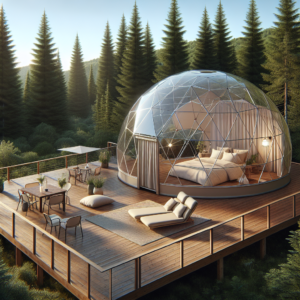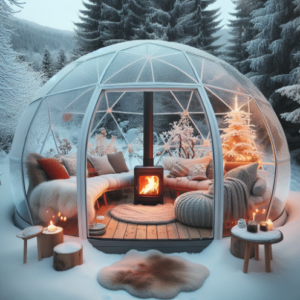
Key Takeaways
-
Geodomes are a sustainable housing option that reduce environmental impact.
-
Solar energy is a clean, renewable resource that geodomes can efficiently utilize.
-
The unique design of geodomes contributes to their energy efficiency.
-
Living in a geodome can help you achieve a smaller ecological footprint.
-
Geodomes paired with solar technology represent the synergy of design and sustainability.
Why Choose a Geodome?
When it comes to sustainable living, the structure of our homes plays a crucial role. Geodomes stand out as an innovative solution. Their spherical design not only turns heads but also slashes energy consumption, thanks to their ability to circulate air and light naturally. This means less reliance on artificial heating and cooling, which is a major plus for the environment and your wallet.
Architectural Ingenuity Meets Nature
The geodome is a marvel of architectural design that seamlessly blends with the natural world. Its geodesic structure is not just for show; it’s a model of strength and efficiency. The dome’s triangular elements distribute stress evenly, making it incredibly resilient to natural disasters like earthquakes and extreme weather. This resilience, combined with the dome’s low-impact construction, makes it an ideal choice for those looking to tread lightly on the earth.
A Smaller Ecological Footprint
Choosing to live in a geodome is a powerful statement about your commitment to sustainability. These structures require less building material per square foot, reducing the demand on our forests and mineral resources. Furthermore, their energy-efficient design means that you’ll use less power to stay warm in the winter and cool in the summer, significantly cutting down on your carbon footprint.
The Sun as Your Power Plant
Now, let’s talk about powering your geodome. Solar energy is the cleanest and most abundant renewable energy source available. By equipping your geodome with solar panels, you’re essentially turning your home into a mini power plant that’s fueled by the sun. This not only reduces your dependence on fossil fuels but also ensures that your home has a minimal impact on the environment.
Understanding Solar Energy Basics
Before we dive into the specifics of solar panels, it’s essential to grasp the basics of solar energy. Solar power is harnessed from the sun’s rays, which are converted into electricity using photovoltaic (PV) cells. These cells are the building blocks of solar panels and when the sunlight hits them, they generate an electric current. What’s truly remarkable is that this process produces zero emissions – it’s clean energy from the sun!
Integrating Solar Panels with Geodomes

Integrating solar panels with geodomes is a match made in heaven. The dome’s curved surface can be an ideal platform for solar panels, as it allows for optimal positioning towards the sun throughout the day. This means more sun exposure and, consequently, more power generated. When installing solar panels on a geodome, it’s important to work with professionals who understand the unique contours and angles to get the best energy yield.
Making the Most of Solar Energy
Having solar panels is a great start, but making the most of the energy they produce is where the real magic happens. It’s not just about generating power; it’s about using it wisely. Smart home technology can help you manage energy consumption, ensuring that the power your geodome generates is used in the most efficient way possible.
Maximizing Energy Efficiency
Maximizing energy efficiency in a geodome goes beyond solar panels. It involves a holistic approach to living sustainably. Think LED lighting, energy-efficient appliances, and smart thermostats that learn your schedule and adjust temperatures accordingly. Even the placement of windows and skylights can be strategic, allowing for passive solar heating and reducing the need for artificial lighting during the day.
-
Install LED lighting to reduce electricity usage.
-
Choose energy-efficient appliances that consume less power.
-
Use smart thermostats to control heating and cooling systems efficiently.
-
Position windows and skylights to maximize natural light and heat.
-
Insulate the geodome properly to maintain temperature without excessive energy use.
-
Consider using energy monitors to track and manage your power consumption.
Smart Energy Storage Solutions
Storing the energy your solar panels produce is as crucial as generating it. Batteries are the key to keeping your geodome powered even when the sun isn’t shining. Modern solar batteries are more efficient and longer-lasting than ever, providing a reliable source of power through the night or during cloudy days. Pairing your solar array with a robust energy storage system ensures a constant supply of clean energy for your geodome.
Living Off the Grid in a Geodome

Living off the grid in a geodome is the ultimate expression of self-sufficiency and sustainability. It means saying goodbye to utility bills and hello to a life powered by the sun, wind, and rain. But it’s not just about disconnecting from the power grid. Off-grid living also involves being mindful of water usage, waste management, and growing your own food. It’s a holistic approach to life that respects the planet and provides an unparalleled sense of freedom.
Water Collection and Purification
Water is life, and in an off-grid geodome, it’s essential to establish a reliable water collection and purification system. Rainwater harvesting is a straightforward and eco-friendly approach. By setting up gutters and storage tanks, you can capture rainwater for your daily needs. But collecting water is just the first step; making it safe to drink is next. Simple purification systems, like gravity-fed filters or solar distillers, can ensure your water is clean and potable.
-
Install gutters around your geodome to collect rainwater.
-
Use storage tanks to hold your harvested water.
-
Invest in a water purification system suitable for your living situation.
-
Consider adding a first-flush diverter to improve water quality by discarding the initial rainwater.
-
Explore natural purification methods like sand filters or charcoal.
Sustainable Waste Management Systems
Waste management is a critical component of sustainable living. In a geodome, composting toilets are an excellent choice as they transform waste into valuable compost for your garden. For greywater, which comes from sinks and showers, a constructed wetland or a sand filter can purify the water naturally before it’s reused for irrigation. These systems not only reduce pollution but also return nutrients to the ecosystem, closing the loop in your waste cycle.
-
Use a composting toilet to manage human waste sustainably.
-
Implement a greywater system for water from sinks and showers.
-
Choose natural waste treatment options like wetlands or sand filters.
-
Reuse purified greywater for garden irrigation, conserving fresh water.
-
Recycle and repurpose materials whenever possible to minimize waste.
Grow Your Own Green Haven
Embracing geodome living means more than just a unique home; it’s about cultivating a green haven where you can grow your own food. This not only reduces your carbon footprint but also provides you with fresh, organic produce right at your doorstep. From raised beds to vertical gardens, there are plenty of ways to maximize your growing space and enjoy the fruits (and vegetables) of your labor.
Creating a Permaculture Landscape
Permaculture is a design philosophy that works with nature, rather than against it. Creating a permaculture landscape around your geodome involves observing the natural patterns and integrating them into your garden. It’s about planting a diversity of species that support each other, building healthy soil, and designing your space to be both beautiful and functional. This sustainable approach to gardening not only provides food but also creates a habitat for wildlife.
-
Observe and mimic natural ecosystems in your garden design.
-
Plant a variety of crops that benefit each other and the soil.
-
Use natural resources, like rainwater and compost, to nourish your garden.
-
Design your space for minimal maintenance and maximum yield.
-
Encourage beneficial insects and pollinators to visit your garden.
Tips for Year-Round Harvesting
One of the joys of geodome living is the ability to harvest your own produce year-round. With the right planning, you can enjoy a continuous supply of fresh food. Start by selecting plants that are suited to your climate and can be grown in succession. Use techniques like mulching to protect your soil and plants in colder months. And don’t forget about indoor gardening; with your geodome’s natural light, you can grow herbs and greens even in the dead of winter.
-
Choose plants that are well-suited to your local climate and seasons.
-
Plan your planting calendar to ensure a succession of crops.
-
Utilize mulching to protect plants from cold and conserve moisture.
-
Experiment with indoor gardening for fresh greens year-round.
-
Consider using greenhouses or cold frames to extend your growing season.
Enhancing Geodome Living: Beyond Sustainable Housing
Understanding the comprehensive sustainability of geodome living involves examining various aspects that contribute to its ecological harmony and self-sufficiency. The table below outlines key elements, shedding light on the diverse facets of geodome living. From the renewable energy sources that power these domes to the strategies for waste management and achieving self-sustainability, each aspect is a crucial component in the broader narrative of eco-conscious living. Delving into these details further enriches our appreciation for the holistic approach that geodomes offer in fostering a harmonious coexistence with our environment.
| ASPECT | INFORMATION |
| Energy Source | Solar panels and wind turbines are common sources of renewable energy for geodome living. |
| Water System | Geodomes can be equipped with water collection systems, rainwater collection, and filtration systems. |
| Waste Management | Composting toilets and septic systems can handle waste in an environmentally friendly way. |
| Insulation | Geodesic domes are naturally well-insulated, but additional insulation can be used to reduce energy needs. |
| Furniture and Appliances | Choose energy-efficient furniture and appliances suited to off-grid living. |
| Food Production | Growing food or raising livestock can help achieve self-sustainability in geodome living. |
| Environmental Impact | Geodomes are a sustainable housing option that reduces environmental impact. |
| Energy Efficiency | Geodomes are naturally energy-efficient due to their insulating properties, leading to lower energy bills and a smaller carbon footprint. |
| Self-Sustainability | Geodomes are a perfect match for those who wish to live in a self-sustaining manner, with water collection systems and ideal growing environments for plants and vegetables. |
Frequently Asked Questions (FAQ)
When considering a shift to sustainable living, questions are bound to arise. Let’s tackle some of the most common queries to help you understand the ins and outs of geodome living and harnessing solar energy.
Can I power a geodome solely with solar panels?
Absolutely! Solar panels can be a powerful source for your geodome, harnessing the sun’s energy to power your entire home. The amount of solar energy you’ll need depends on your location, energy usage, and the size of your geodome. The key is to calculate your energy needs accurately and design a solar panel system that can meet those demands. Many geodome dwellers live comfortably with solar energy as their sole power source, proving that with the right setup, you can too.
Is it expensive to build a geodome with solar capabilities?
Initial costs might seem steep, but think of it as an investment in your future. Building a geodome with solar capabilities does require upfront spending, but it pays off in the long run with reduced energy bills and minimal maintenance costs. Plus, with various financing options, tax credits, and rebates available for solar installations, the financial impact can be significantly lessened.
How does the geodome’s design contribute to energy efficiency?
The geodome’s unique structure is a natural ally in energy conservation. Its spherical shape allows for even distribution of heat and cold, minimizing energy loss. Strategic placement of windows and skylights maximizes sunlight entry, reducing the need for artificial lighting. All these factors contribute to a home that’s not just beautiful but also incredibly energy-efficient.
What are the challenges of living off the grid in a geodome?
While off-grid living offers freedom and sustainability, it also comes with its set of challenges. Water supply, waste management, and energy storage require careful planning and management. Additionally, you’ll need to be proactive in maintaining your solar panels and other systems. But for those willing to embrace these challenges, the rewards of a self-sufficient, eco-friendly lifestyle are unparalleled.
Where can I learn more about installing solar energy systems in a geodome?
You can learn more about installing solar energy systems in a geodome from local renewable energy providers, online resources, and community workshops. It’s also beneficial to consult with professionals who have experience with geodomes and solar installations.
In conclusion, geodome living paired with solar energy represents a powerful step towards a sustainable future. By embracing this lifestyle, you’re not just building a home; you’re joining a movement that values resilience, self-sufficiency, and harmony with nature. The journey to sustainable living is an ongoing process, filled with learning, growth, and community. As you embark on this path, remember that each step you take is a step towards a healthier planet for generations to come.




